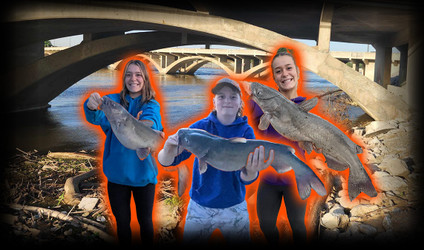Fishing Bridges for Cats!
Posted by Joel Johnson on 20th Jun 2024
Fishing Bridges
for Cats!
One of the best places to target catfish during spring and summer is from bridges over creeks and rivers. Bridges provide anglers with an elevated position that increases visibility and avoids having to tramp through irritating nettles, poison ivy, ticks, and mud. However, not every bridge is created equally with regards to structure and fish-holding potential. As a result, anglers should always analyze the water above and below a bridge before fishing it, and the most important variable is water depth. It doesn’t matter how much structure is present in a given section of river if the water is only ankle deep.
One of the best places to target catfish during spring and summer is from bridges over creeks and rivers. Bridges provide anglers with an elevated position that increases visibility and avoids having to tramp through irritating nettles, poison ivy, ticks, and mud. However, not every bridge is created equally with regards to structure and fish-holding potential. As a result, anglers should always analyze the water above and below a bridge before fishing it, and the most important variable is water depth. It doesn’t matter how much structure is present in a given section of river if the water is only ankle deep.
As a rule of thumb, I want access to 3-5’ of water, at a minimum, within a 25 yard cast from the bridge rail. Sections shallower than this rarely hold significant populations of cats, and although you can occasionally catch them passing through, in my experience, deeper water is better for consistent success. Ideally, you want to find locations with 3-5’ of water immediately below the bridge with downstream access to deeper mid-channel scour holes, sweeping cut banks, tangled log jams, grassy points, or rocky riprap banks.
Spots that have a mixture of depth and diverse cover features can hold a ton of catfish. Bridge pilings and the debris that collects above and below them create current breaks, scour holes, and adjacent cover that form ideal ambush spots. In these areas, catfish can simply lie in wait out of the current, dart out for a quick bite, and retreat safely to their lair.
To present your bait most effectively, cast so that it settles on the bottom, just upstream from holes, structure, eddies, and current seams. This approach ensures the current will carry the scent and vibration of your bait downstream to the fish, leaving a trail of breadcrumbs for catfish to follow.
When a fish is caught, to mitigate the risk of losing it by trying to swing or reel it over the bridge rail, make sure to bring a WST eXtender landing net to scoop them up. To further reduce the chances of losing fish, send a buddy down to the bank and play the fish to them from above for easier landing. While it can be done, trying to swing catfish over the bridge rail very often results in broken lines, snapped rods, and lost fish, especially on catfish in excess of a couple of pounds.
When bridge fishing, anglers often encounter heavy current that requires more weight for baits to reach the bottom and hold their position. In addition, big catfish almost always dive for cover when hooked, and a beefy rod and heavy line can be the difference between a catch and a snag. As a result, for this application I rely on the Whisker Seeker GFX, FMJ, or Hog Seeker rods to assist in steering and horsing fish away from obstacles and into the net. I pair these stout rods with a WST Seeker 60 or Seeker 60 Pro baitcasting reel due to their smooth retrieve, extra line capacity, and exceptional drag performance. These combinations provide all the horsepower you need while bridge fishing for big channel cats as well as trophy flatheads.
When water levels are stable and clarity is good, I also bring a rod for running a slip bobber rig. Floating a chunk of cut bait, whole leopard frog, or live chubs along rip rap, past grassy points, and around eddies can generate bites when other presentations don’t. For this application, I like a medium-light power, fast action, 7-12’ casting or spinning rod. It’s crucial the reel has at least a couple hundred yards of capacity, and to avoid snags, I like to run a high visibility, low-stretch, floating line, like Berkley Fireline, that stays out of distant underwater obstacles. A long, forgiving rod with plenty of bend, paired with a low stretch line, enables anglers to steer floats precisely downstream. Combined with circle hooks, this setup dramatically increases hook-up percentages, especially when floating baits 50 yards and more downstream to cover large sections of stream.
Fishing bridges for catfish is a relaxing and comfortable way to fish without the added complexity of a boat or irritation from stinging plants and bugs. Moreover, bridges with the right mix of water depth and cover features can be extremely productive for both numbers of eaters and trophy catfish. If you’ve never tried fishing bridges for catfish, give it a go this summer, and you may be surprised at how effective it can be. Regardless of the outcome, with lawn chairs strategically located near your rods and cooler, there’s nothing better than kicking back with friends and family and putting your feet up on the rail while waiting for a bite.

